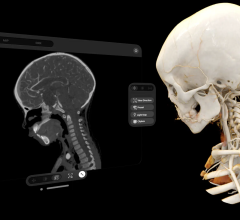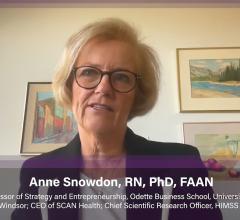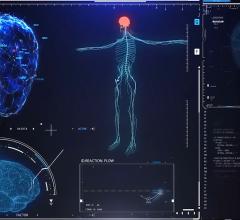
Health systems are recognizing that aggregated cardiac imaging data is an asset rather than a liability. Disparate systems and siloed databases result in unnecessary time spent compiling data from across the organization. It can be challenging for imaging leaders and care teams to stay abreast of digital innovation, and drive adoption across the health system to realize the ROI and ultimately enhanced patient care.
Consolidating the data that has traditionally been siloed can help providers realize performance advantages, proving pivotal to demonstrating value in this era of value-based care. The key, says Jennifer Hall, Ph.D., FAHA, chief of data science and the co-director of the Institute for Precision Cardiovascular Medicine at the American Heart Association, is creating and maintaining a simple user experience.
“We have to remember technology is meant to make things simpler,” Hall says. “It's meant to fade into the background and simply allow the clinician to do their job. Understanding simple things about where to put the button that they click, how many clicks it will take, and whether the data auto-populates, makes the clinician's job easier.”
Scott Flamm, M.D., head of the section of cardiovascular imaging in the Cleveland Clinic Division of Radiology, notes that the latest cardiovascular imaging tools provide a wealth of data that can be overwhelming for some users. “When we get to the point of processing the information, integrating it, and converting that into quantitative information, it can sometimes be a little bit complex,” Flamm says. “So we really want to make this as efficient as possible and as simple as possible. The model should be to keep it simple. The simplest interface possible to allow us to put out all this information is really the most useful, because people will use it then.”
Implementing AI to Aid Cardiology Structured Reporting
AI-driven tools and capabilities can also help increase the adoption of structured reporting, but Hall says these tools should operate in the background, keeping the focus on user experience and clinical workflow efficiency. “Data scientists may have very challenging algorithms and a lot of math behind the machine learning and artificial intelligence, but what the clinician needs to see is simply the output,” Hall says.
Often, when bringing a product to market, Flamm says IT vendors will focus on producing the minimum viable product, out of practical or time considerations. “It's really important not to settle there, but to be able to put in the best interface possible so that it is simple and easy to use, pulls in all this relevant information about the patient, and really makes it so that the user wants to use it.”
Flamm sees potential for AI and machine learning to make needed connections across disparate systems. “I would hope that this is where AI and machine language could come in and do all of that matching for us, and provide all of the cross references and the cross talk between and among those databases so that we could have a common database and repository of information to help drive that clinical decision making,” he says.
Managing a Wealth of Cardiac Imaging Data in a Single Location
Cardiovascular imaging generates a wealth of imaging data and a significant part of that data is structured. Often the data is stored in multiple places, making it a challenge to derive meaningful, outcome-driven insights, and providing right data for the right treatment to the clinician at the right time. Organizations have begun to change this dynamic, learning ways to share that data across departments.
“We've seen a lot of great progress in the last few years. In today's environment everybody is trying to share,” Hall says. “By doing that, you bring data discovery, and discovery for the patient, so much faster. It's all accelerated if you can share data, build the statistical power, to really have the evidence behind things that we're doing. It's not such a big pill to swallow if you take it one step at a time and start building pieces within each system, each clinical organization.”
One way organizations are able to move all data to a singular location is by utilizing the cloud and implementing cloud-based applications. While the cloud has its own considerations around data security and privacy, a benefit to a cloud system is the flexibility to quickly push system updates across all sites.
“What cloud can bring to the table here is the ability to very frequently update the user experience to listen to customers, and actually close the loop on feedback from the field very quickly,” says Itai Galili, director of cardiovascular product management for Change Healthcare. “You don't need to get a fix out there and wait for each and every site to deploy it.”
Proving the Value of Cardiac Structured Reporting
When demonstrating the value of structured reporting to the overall organization, Flamm says it’s important to be able to quantify information in an easy and reproducible way. For example, a procedure in the EP lab can generate information about diagnostics, operations and throughput, and even resource use for devices, electricity or water. By quantifying all this information, departments can look at ways to optimize all the elements of a program, as well as the program as a whole.
“We tend to come at it from pieces and parts and we need to do it from a more holistic process,” Flamm says.
For Galili, the value comes in helping physicians keep their focus on the patients and not on the technology. This could mean taking all the high volume repetitive tasks that are happening every day and automating them through AI machine learning. “One example would be a lot of our customers indicate the challenge with image quality in measurement variability between different modalities and different technicians with different skill sets and experiences. And that's something that AI is proven to be able to reduce variability significantly,” Galili says.
Overall, Hall says that the most successful data programs are those that keep the focus on providing the best clinical care at the least expense.
“Again, it’s getting the data in the right place at the right time. If the clinician side, the administration side and the data science side keep that all in the back of their minds as the main goal, then you'll have a better chance at success,” Hall says.
Editor’s Note: This cardiovascular information systems (CVIS) article is a summary of a Change Healthcare sponsored webinar from December 2021 about user experience in structured reporting. You can watch the full webinar here.


 May 01, 2024
May 01, 2024 








